not sure yet Jim....might be a 2-8-2. I already did a 4-8-4. But you never know.
|




|
I think the picture below would meet the criteria for "making anything cool", the only issue is that I took the picture and submitted it to the editor of the Train Collectors Quarterly back in January so, even though it is the cover of the just published July issue of the Quarterly, it might not meet the criteria for "lately". ![]()
As the opening credits of many movies state "the following is based on true events" - the key word is based - I did take some artistic license.
The full story from Southern Railway Remembered is as follows:
"At the Alexandria Station the main line tracks separated into freight train tracks and passenger train tracks. The freight tracks, behind the northbound passenger waiting room, went into Potomac Yard. One morning a southbound train stopped right in front of the passenger sheds to wait for clearance. From the Alexandria station past Duke Street was a long curve, and incoming freight trains had a signal just before they got to the Duke Street Bridge. Because of the curve, northbound engineers had to depend on their firemen to
let them know whether or not the signal was clear.
An RF&P freight was coming in, and when it got close to the curve the engineer asked his fireman how the signal was. The fireman replied," I can't see the signal for that caboose is blocking my view." The engineer threw the brakes into emergency-too late! He rammed the Southern caboose and stood it on end. The flagman saw him coming in time to get out of the way. He took off down Duke Street. Someone stopped him and asked why he was in such a hurry. He pointed back toward the bridge; the caboose was on fire, and flames were going high above the bridge. Fortunately, the Southern conductor had already started walking to the front of his train when the train struck so no one was injured. There were some hard feelings however. The conductor had bought a couple of hams in Monroe and left them on the caboose. By the time he got back to what was left of the caboose, his hams were cooked well done".
The diorama
For the diorama I first did a trial set up to get a sense of camera angles and the distance I would need to be away from the setup in order to guarantee everything was in focus. I had originally thought about having a wrecking crane in the background but the camera angle was such that the boom from the crane was more of a distraction than a complementary element to the picture. I tried different station locations and tried to think of things that would decrease the blank space above the main picture elements. I settled on the water tower and played with different positions of the tower, the station and positions of the wreck – particularly the locomotive.
In the first attempts I thought too much of the engine was concealed. After a couple of tries I finally found a derailed position that permitted one to see most of the front of the engine even with the caboose hanging in the position it was in. I dismantled one gondola to scatter wheel sets and I removed the wheels and axles from one of the caboose trucks.
Once I had the basic setup, I spent some time arranging figures – I took a number of test shots with figures in various locations trying to make the figures the focal point. The main issue with the figures was that I wanted to have a hapless fireman trying to explain things to the division manager with the engineer just looking on. Since I couldn't find any figures to match my needs for the fireman and the division super I kitbashed them.
The fireman with his palms turn outward in supplication is a heavily modified Plasticville figure. In order to get the right pose I spent a lot of time running between my wife's full length mirror in the bedroom and my work bench. I would stand in front of the mirror, take the stance I wanted to create, stare at my reflection for awhile, run down to the basement, sculpt a little of the figure, add a little squadron green putty, etc. and repeat.
The division super is a heavily modified Bachmann figure. The figure didn't scale out to 1:48 so I had to do some serious surgery with respect to sectioning his arms, legs and torso to "cut him down to size."
The engineer and the older railroad employee looking at the wrecked engine are commercial cast figures I painted and the intrepid newshound with the camera is from the Arttista Gazette.
As for the artistic license - the actual wreck only involved the destruction of the caboose - there was no derailment of the train that hit it.
Robert S. Butler posted:I think the picture below would meet the criteria for "making anything cool", the only issue is that I took the picture and submitted it to the editor of the Train Collectors Quarterly back in January so, even though it is the cover of the just published July issue of the Quarterly, it might not meet the criteria for "lately".
As the opening credits of many movies state "the following is based on true events" - the key word is based - I did take some artistic license.
The full story from Southern Railway Remembered is as follows:
"At the Alexandria Station the main line tracks separated into freight train tracks and passenger train tracks. The freight tracks, behind the northbound passenger waiting room, went into Potomac Yard. One morning a southbound train stopped right in front of the passenger sheds to wait for clearance. From the Alexandria station past Duke Street was a long curve, and incoming freight trains had a signal just before they got to the Duke Street Bridge. Because of the curve, northbound engineers had to depend on their firemen to
let them know whether or not the signal was clear.
An RF&P freight was coming in, and when it got close to the curve the engineer asked his fireman how the signal was. The fireman replied," I can't see the signal for that caboose is blocking my view." The engineer threw the brakes into emergency-too late! He rammed the Southern caboose and stood it on end. The flagman saw him coming in time to get out of the way. He took off down Duke Street. Someone stopped him and asked why he was in such a hurry. He pointed back toward the bridge; the caboose was on fire, and flames were going high above the bridge. Fortunately, the Southern conductor had already started walking to the front of his train when the train struck so no one was injured. There were some hard feelings however. The conductor had bought a couple of hams in Monroe and left them on the caboose. By the time he got back to what was left of the caboose, his hams were cooked well done".The diorama
For the diorama I first did a trial set up to get a sense of camera angles and the distance I would need to be away from the setup in order to guarantee everything was in focus. I had originally thought about having a wrecking crane in the background but the camera angle was such that the boom from the crane was more of a distraction than a complementary element to the picture. I tried different station locations and tried to think of things that would decrease the blank space above the main picture elements. I settled on the water tower and played with different positions of the tower, the station and positions of the wreck – particularly the locomotive.
In the first attempts I thought too much of the engine was concealed. After a couple of tries I finally found a derailed position that permitted one to see most of the front of the engine even with the caboose hanging in the position it was in. I dismantled one gondola to scatter wheel sets and I removed the wheels and axles from one of the caboose trucks.
Once I had the basic setup, I spent some time arranging figures – I took a number of test shots with figures in various locations trying to make the figures the focal point. The main issue with the figures was that I wanted to have a hapless fireman trying to explain things to the division manager with the engineer just looking on. Since I couldn't find any figures to match my needs for the fireman and the division super I kitbashed them.
The fireman with his palms turn outward in supplication is a heavily modified Plasticville figure. In order to get the right pose I spent a lot of time running between my wife's full length mirror in the bedroom and my work bench. I would stand in front of the mirror, take the stance I wanted to create, stare at my reflection for awhile, run down to the basement, sculpt a little of the figure, add a little squadron green putty, etc. and repeat.
The division super is a heavily modified Bachmann figure. The figure didn't scale out to 1:48 so I had to do some serious surgery with respect to sectioning his arms, legs and torso to "cut him down to size."
The engineer and the older railroad employee looking at the wrecked engine are commercial cast figures I painted and the intrepid newshound with the camera is from the Arttista Gazette.
As for the artistic license - the actual wreck only involved the destruction of the caboose - there was no derailment of the train that hit it.
Makes me think of some of Ward's cover photo's.
Steve
Thank you Steve. You'd be surprised (or maybe not) at the number of people who have told me the same thing - not only about this cover but about the cover I did last year as well. I appreciate the compliments.
@Arne @sncf231e thanks for the feedback regarding the Hornby station! I like the one that was previously posted- Man was that cool! That said, for now at least, I’m gonna keep mine as is- although stairs in the future would be cool!
and thanks again, @Arne, for the info about the KB Bing double logo. Happen to have a solely Bing version similar to the first picture you posted.
Also is my first Bing car, in general, so that one has got a special place with me. I do like the gold trim paint that KBN added , nice touch.
Robert S. Butler posted:I think the picture below would meet the criteria for "making anything cool", the only issue is that I took the picture and submitted it to the editor of the Train Collectors Quarterly back in January so, even though it is the cover of the just published July issue of the Quarterly, it might not meet the criteria for "lately".
As the opening credits of many movies state "the following is based on true events" - the key word is based - I did take some artistic license.
The full story from Southern Railway Remembered is as follows:
"At the Alexandria Station the main line tracks separated into freight train tracks and passenger train tracks. The freight tracks, behind the northbound passenger waiting room, went into Potomac Yard. One morning a southbound train stopped right in front of the passenger sheds to wait for clearance. From the Alexandria station past Duke Street was a long curve, and incoming freight trains had a signal just before they got to the Duke Street Bridge. Because of the curve, northbound engineers had to depend on their firemen to
let them know whether or not the signal was clear.
An RF&P freight was coming in, and when it got close to the curve the engineer asked his fireman how the signal was. The fireman replied," I can't see the signal for that caboose is blocking my view." The engineer threw the brakes into emergency-too late! He rammed the Southern caboose and stood it on end. The flagman saw him coming in time to get out of the way. He took off down Duke Street. Someone stopped him and asked why he was in such a hurry. He pointed back toward the bridge; the caboose was on fire, and flames were going high above the bridge. Fortunately, the Southern conductor had already started walking to the front of his train when the train struck so no one was injured. There were some hard feelings however. The conductor had bought a couple of hams in Monroe and left them on the caboose. By the time he got back to what was left of the caboose, his hams were cooked well done".The diorama
For the diorama I first did a trial set up to get a sense of camera angles and the distance I would need to be away from the setup in order to guarantee everything was in focus. I had originally thought about having a wrecking crane in the background but the camera angle was such that the boom from the crane was more of a distraction than a complementary element to the picture. I tried different station locations and tried to think of things that would decrease the blank space above the main picture elements. I settled on the water tower and played with different positions of the tower, the station and positions of the wreck – particularly the locomotive.
In the first attempts I thought too much of the engine was concealed. After a couple of tries I finally found a derailed position that permitted one to see most of the front of the engine even with the caboose hanging in the position it was in. I dismantled one gondola to scatter wheel sets and I removed the wheels and axles from one of the caboose trucks.
Once I had the basic setup, I spent some time arranging figures – I took a number of test shots with figures in various locations trying to make the figures the focal point. The main issue with the figures was that I wanted to have a hapless fireman trying to explain things to the division manager with the engineer just looking on. Since I couldn't find any figures to match my needs for the fireman and the division super I kitbashed them.
The fireman with his palms turn outward in supplication is a heavily modified Plasticville figure. In order to get the right pose I spent a lot of time running between my wife's full length mirror in the bedroom and my work bench. I would stand in front of the mirror, take the stance I wanted to create, stare at my reflection for awhile, run down to the basement, sculpt a little of the figure, add a little squadron green putty, etc. and repeat.
The division super is a heavily modified Bachmann figure. The figure didn't scale out to 1:48 so I had to do some serious surgery with respect to sectioning his arms, legs and torso to "cut him down to size."
The engineer and the older railroad employee looking at the wrecked engine are commercial cast figures I painted and the intrepid newshound with the camera is from the Arttista Gazette.
As for the artistic license - the actual wreck only involved the destruction of the caboose - there was no derailment of the train that hit it.
Sam, I saw your credit for the cover when my copy arrived earlier this week. Great work!
George
RSB: Ward would be proud of your cover! Rest assured you are in GOOD company, and your efforts bore fruit!
With some time off for the holiday I've been able to complete assembly of my standard gauge Kingsbury single truck Birney. The project started with the purchase of a Kingsbury floor toy trolley that someone had already very carefully taken apart and removed the old friction mechanism from. Then I lucked into a loose McCoy mechanism at the local TTOS meet that came from a John Daniels GG1. I repaired the two failing wheels with cyanoacrylate (based on advice from repair expert Larry Pearson) and removed the plastic GG1 side frames.
Mating the trolley with the drive was accomplished by cutting several slots into the old trolley floor. I then added window glazing and a pair of bulbs, and the finishing touch was a pair of Ives pilots supplied by Bruce Peterson. I still need to strengthen up the floor a bit on one end- there's a big round hole where the old friction mechanism used to be and so the whole floor bends there.
This car joins the Kingsbury double-truck Birney motor/trailer set I posted about previously. Some photos and a video are attached.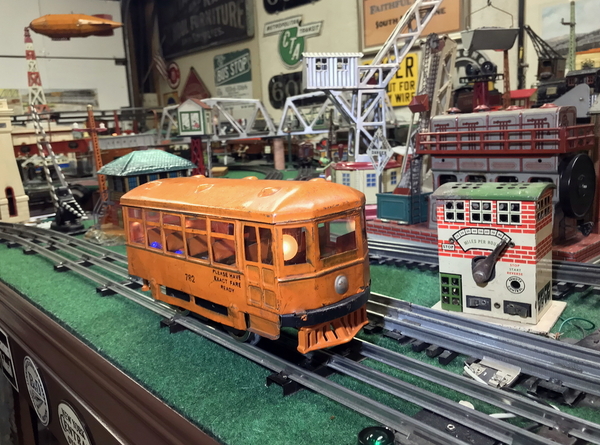
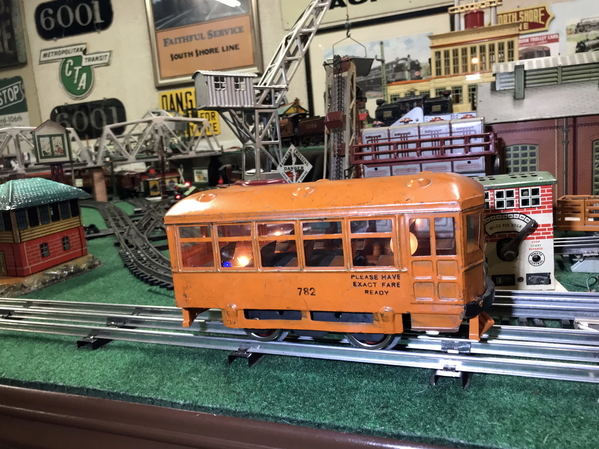
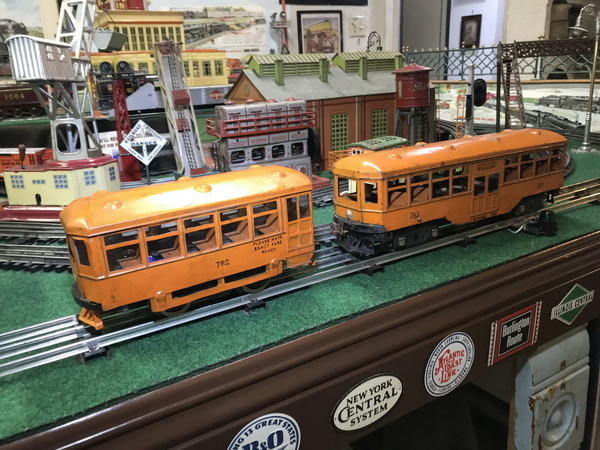
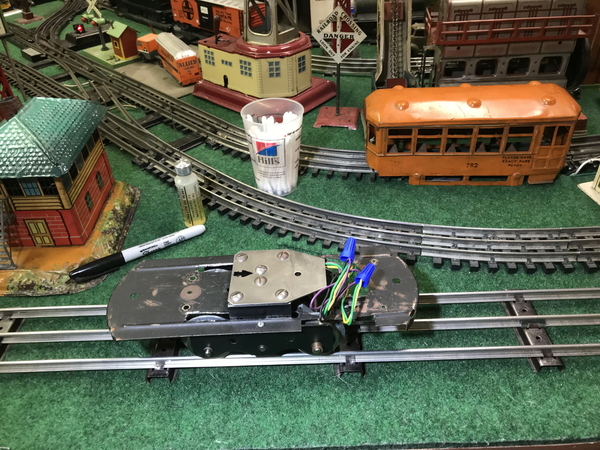
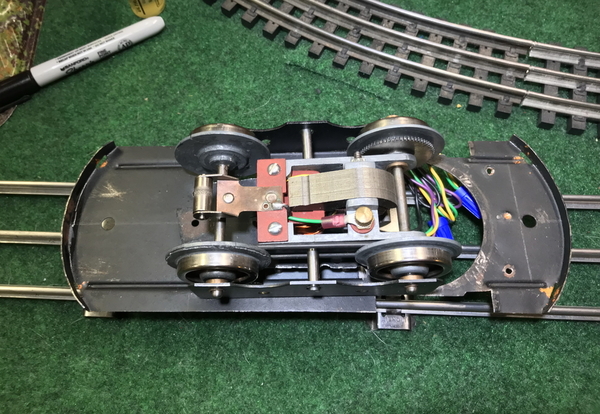
Picked this up at a flea market-antique mall. Not usually a steam locomotive guy but The front coupler had me intrigued, didn’t really know what I was getting...or getting myself into lol(spent the last 10 hours working on it). Unfortunately no tender but this dude it’s pretty cool
Awesome find! I'd love to find one of those, and be able to afford it. You'll be recieving a reply from a tall dark man from Yonkers shortly......![]()
StevefromPA posted:
Steve, you have a nice example of a prewar 203. It has a shorter boiler than the 227-series of switchers and comes with a shorter tender, with Lionel Lines instead of Pennsylvania on it. You should have a prewar box coupler on it.
Tom
Haha @Steamer I’ll have to be on the look out, just make sure to knock
@PRR8976 thank you. I wish I had the tender![]() after reading about this guy it seems to be a really cool loco to run with the tender that can have a bell or a light. I’d assume those tenders are probably hard to come by without the switcher attached to it. But gotta get that guy working first!
after reading about this guy it seems to be a really cool loco to run with the tender that can have a bell or a light. I’d assume those tenders are probably hard to come by without the switcher attached to it. But gotta get that guy working first!
just a heads up,,,,MNCW is the Yonkers boy,,,,![]()
@Steamer lol makes sense. Hence his awesome website on these switchers. Good call on that one haha
StevefromPA posted:
Steve,
Very, very nice! I wish we had flea markets and antique malls here in Arkansas like the ones you obviously have in PA. Unfortunately, we don't. There's lots of outdoors and nature in the "Natural State" but not many toy trains like back on the East Coast.
Bob Nelson
StevefromPA posted:Picked this up at a flea market-antique mall. Not usually a steam locomotive guy but The front coupler had me intrigued, didn’t really know what I was getting...or getting myself into lol(spent the last 10 hours working on it). Unfortunately no tender but this dude it’s pretty cool
I've had one of these since I was a boy. One of the main rods remains 'repaired', ie spliced, as we could not find a part back then. Mine has the bell tender (another repair on the bimetal wire thing that cycles the bell. Runs like a little champ. Since I was doing postwar back then, tender trucks got swapped out for postwar coupler types.
These guys seem to be pretty rare, I suspect more of the scale versions were made than these. Lionel continued with the 4 wheel version after the war (1656, 1615 etc), but this one is the real deal .
Jim
My Ives 3250 has been giving me trouble for awhile now and finally kind of “conked out”. Don’t think the repairs should be that much- before she totally wouldn’t run she would require me to give her a little push first.
regardless, found a good deal on that auction website for an Ives 3252. Besides the light not working, runs like a champ and I like the brass plates. The green color also fits in better with My consist. Also has a reverse Lever that functions fine.
At the end of the day, can always count on the Lionel 254e though!
Also, update on the prewar 203 B6 switcher- cleaned the e-unit, took out the old wires and soldered in new ones- still no dice. Taking it to my repair guy on Tuesday. After that I’m gonna decide if I wanna keep it or sell it.
Jim Waterman posted:StevefromPA posted:Picked this up at a flea market-antique mall. Not usually a steam locomotive guy but The front coupler had me intrigued, didn’t really know what I was getting...or getting myself into lol(spent the last 10 hours working on it). Unfortunately no tender but this dude it’s pretty cool
I've had one of these since I was a boy. One of the main rods remains 'repaired', ie spliced, as we could not find a part back then. Mine has the bell tender (another repair on the bimetal wire thing that cycles the bell. Runs like a little champ. Since I was doing postwar back then, tender trucks got swapped out for postwar coupler types.
These guys seem to be pretty rare, I suspect more of the scale versions were made than these. Lionel continued with the 4 wheel version after the war (1656, 1615 etc), but this one is the real deal .
Jim
Awesome story, @Jim Waterman ! Thank you for sharing. The responses to my purchase of this 203 switcher, I.e. members like you saying “this one is the real deal” makes me teeter closer to the edge of keeping it. I have a pre-war she’ll tender from my grandpop that, due to issues with the solonoid, I had the one coupler replaced so it’d be a good transition piece. Again, thanks for sharing, I hope I get to see my B6 run like a champ justlike you have gotten to see yours!
Access to this requires an OGR Forum Supporting Membership
